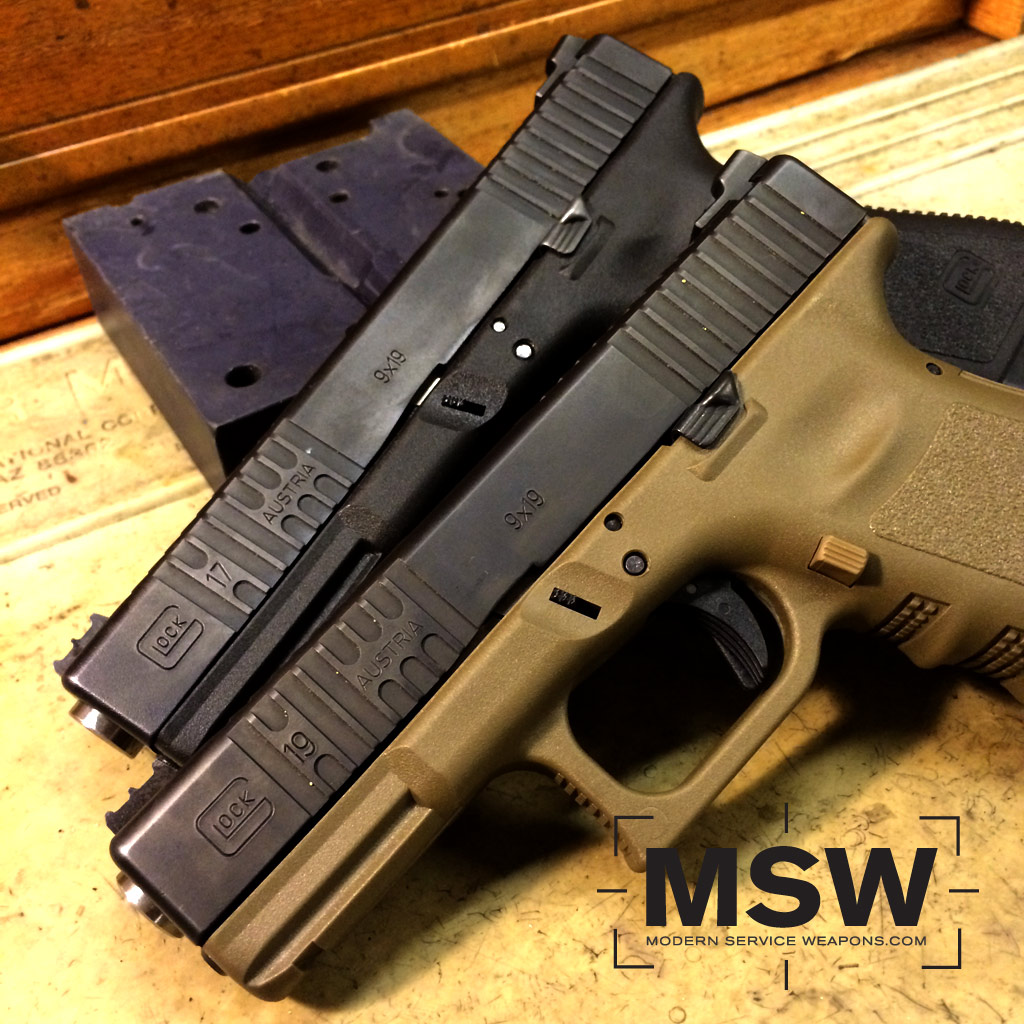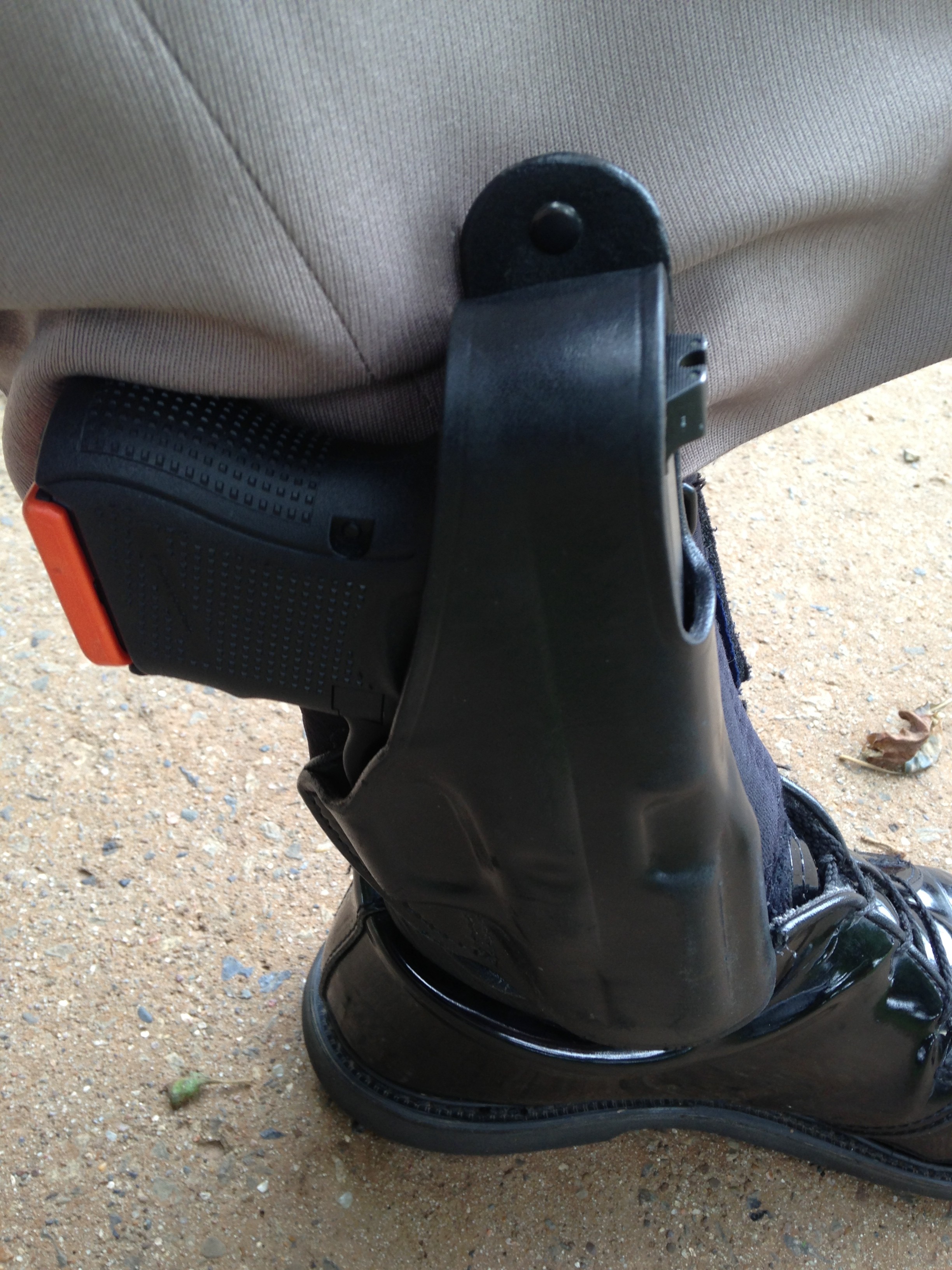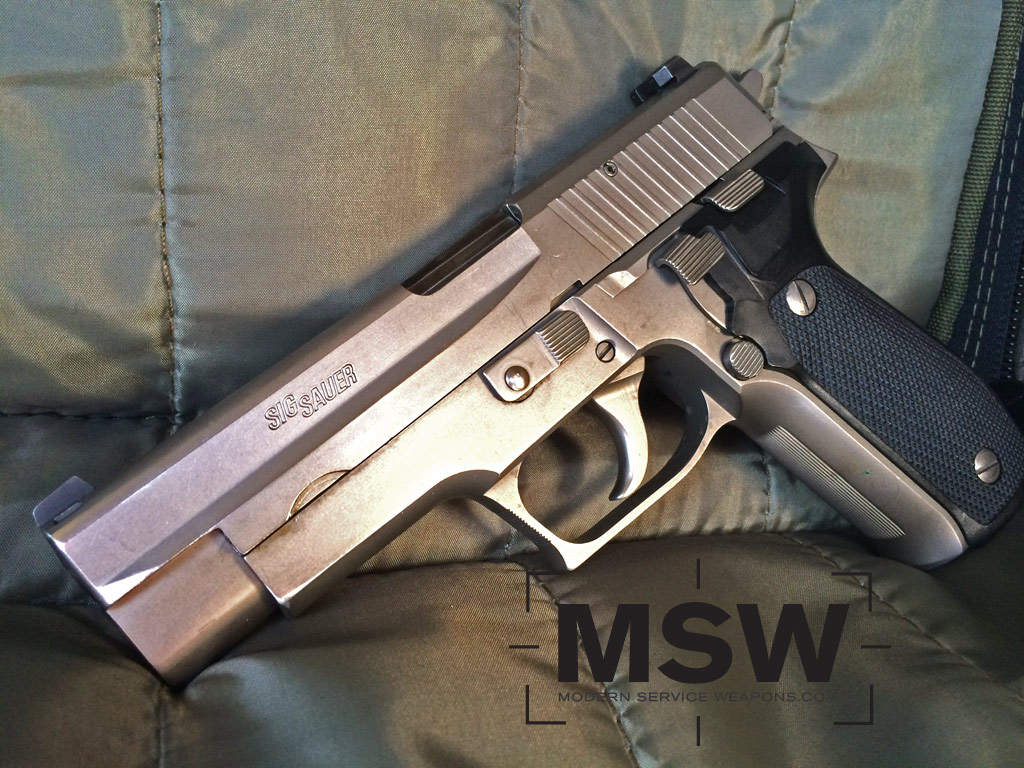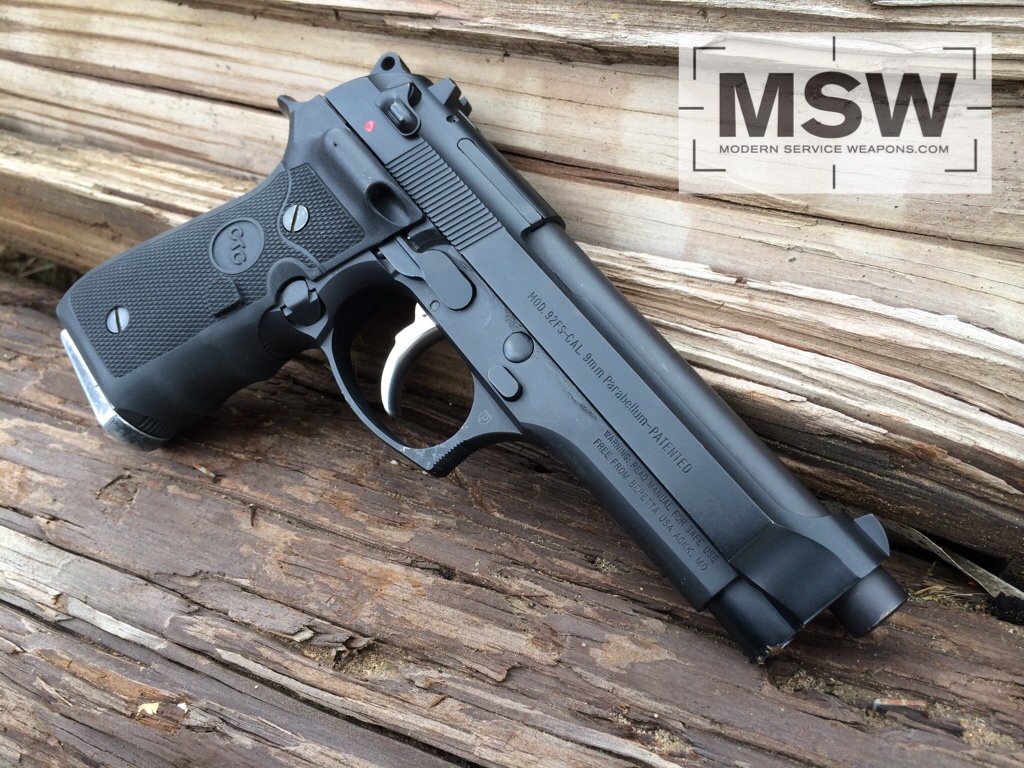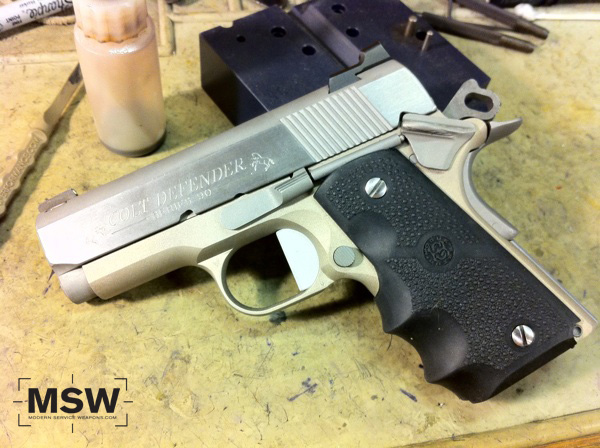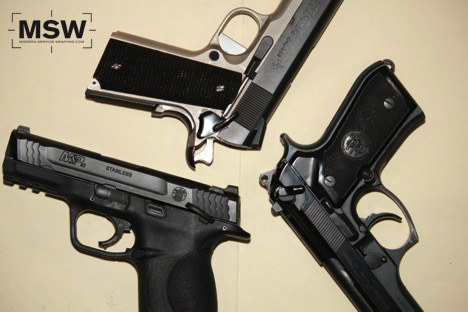Disturbingly, Hilton and I are both hearing more and more about failures on the range or in classes of heavily modified polymer pistols. There are more and more “shops” coming out of the woodwork advertising customization and enhancement of Glocks and M&Ps and not all are created equal. Many commonly offer CNC machine work or grip texturing to improve the handling characteristics of the pistol. Some other shops offer “improved” fire control parts to lighten and or improve the feedback of the trigger. Unfortunately, most of the time, modification of the factory fire control parts ends up meaning a decrease in reliability and/or durability of the weapon.
Category Archives: Modern Service Pistols
First Review- SIG Sauer P320
I picked up my SIG Sauer P320 yesterday and took it to the range for a quick 150 round workout. My initial impressions were very positive.
This morning, I put another 300 rounds through it and it confirmed my initial thoughts. Continue reading
Picture of the Day- They are in the wild……
Practice with Back Up Guns
I think that most all police officers, and some armed citizens to a point, are carrying back up guns as a norm. Back in the day, most carried Walther PPK’s and Smith and Wesson J-frames as a back up gun. When the Glock 26/27 debuted, the world was set on its ear. The compatibility alone made sense for the agencies that issued the G17/22 to add the “baby” Glocks as back ups. Continue reading
Sight Radius- What role does it really play in a defensive pistol?
Recently, I’ve been shooting some drills from concealment with various pistols from the Glock 9mm family. My thinking over the years on a defensive pistol is that it should be one that fits a couple of simple criteria: a pistol that is reliable, and one that you’ll carry every day. For some, a Ruger LCP fits the bill. A Ruger in the pocket always beats a custom M1911 in the car when it comes down to needing it now. However, I’ve always advocated carrying the most gun that you can comfortably carry. Some will say there is an “average” gun fight (IE 1-3 feet, 1-3 Seconds, 1-3 rounds fired). I feel that there is no such thing as “average” and if I can perform these tasks at 25 yards at speed, the close in stuff is a chip shot. However, merely banging away at contact distance doesn’t equate to hitting stuff at distance if it becomes a lifesaving requirement. But, that is a conversation for another day. Continue reading
LEGAL RAMIFICATIONS OF HANDGUN MODIFICATIONS AND NON-FACTORY STANDARD REPLACEMENT PARTS
Do an internet search of the first five words of this post’s title. You will get enough distinct hits for days of reading, as a hundred or more (in the first thousand or so) appear to contain substantive material worthy of consideration. In short, longstanding advice — from homicide investigators, prosecutors, defense lawyers, gun writers, bloggers, the self-defense firearms community, and those who actually consult and testify as experts in criminal and civil trials — urges (prudently) leaving a defensive handgun factory box stock, to avoid adverse consequences in a legal proceeding. Critics of such advice note (correctly) a near dearth of anecdotal trial reports and published appellate decisions suggesting there are adverse legal ramifications on account of modification to or installation of a non-factory standard replacement part (NFSRP) into a defensive handgun. So, are there legal ramifications or not? Yes, there can be. Are they adverse? Perhaps. Should one then automatically forgo a useful, desirable, and common handgun modification or NFSRP? Probably not. Continue reading
The Modified Glock
Glocks tend to run great out of the box. They are reliable, and accurate. I have a friend who shoots a lot of 3 gun and IDPA with a completely stock Glock 17 with the plastic sights, and does it well. Some folks like to simply change out of the plastic “filler” sights that come stock, for aftermarket sights such as 10-8’s.
I like my Glocks a bit more modified. Above is a brand new Gen4 G19 that is a recent acquisition. The gun shot great out of the box, but there are changes that I like to make for my own benefit. Continue reading
Wilson Combat to Host Ernest Langdon in TX
On the heels of the announcement of the collaboration between Wilson Combat and Beretta guru Ernest Langdon, Wilson Combat has just announced they will be hosting Ernest for a “How to Run a Beretta Handgun” Course at the Wilson Ranch in Cuthand, Texas. Die hard Beretta aficionados will immediately recognize Ernest as the industry’s most knowledgeable instructor on running and modifying the Beretta handgun. A prior member for the Beretta shooting team, Ernest’s competition career has earned him countless national IDPA and USPSA titles with a double action pistol. He also has extensive military experience as an end user and instructor.
The Sig P226: The Unrecognized Workhorse
In keeping with our recent series, we’ve been looking at various commonly issued practical service weapons that don’t get a whole lot of love. The Sig P226 certainly falls into that category. Most of us who have been around for a while know this pistol very well, but it seems the new generation of shooters don’t give this pistol much love. Originally designed to compete with the Beretta 92 to replace the M1911A1 pistols, the P226 has been adopted by countless domestic law enforcement agencies and has also been in use by the US Navy SEAL Teams since the 1980s. The P226 also saw service in the FBI, DHS, and served as an interim weapon to replace the Browning Hi Power. Many of the design features came from the P220 and P225. A double column magazine holds 15 rounds of 9mm ammunition. In its decades of service, P226 has developed a reputation of being a reliable and robust pistol.
Beretta 92FS: The Forgotten Service Pistol
A couple weeks ago, our friends over at the gunnuts.net blog wrote about The Underrated Beretta 92, which prompted me to look back at my own experiences with the platform. Where I work, officers can choose to carry a personal sidearm as long as they can qualify with the pistol and that the handgun itself meets some basic parameters. However, the default issue pistol is still the Beretta Model 92FS, and most of our sworn personnel carry it since it is provided by the agency. So we on the range staff have quite a bit of experience with the pistol; as a result, I’ve formed a few opinions on its attributes and performance characteristics. Continue reading
The Browning Hi Power: Yesterday’s 9mm Service Pistol
Known as the most evolved of John Moses Browning’s pistol designs, the Browning Hi Power is one of the most beloved semi-automatic pistols ever. And why shouldn’t it be? It was designed by the single most influential firearms designer in history, features a double-stack high-ish) capacity magazine, a grip suitable for small hands, and is chambered for the most popular service pistol cartridge in the world.
THE POLICE MARKSMAN : STILL A PLACE TO “GET SOME”
I previously noted in an MSW post the return of The Police Marksman. You can read/download the latest issue, eBook style here. In addition to the long running “Officer Down” column (the John Schoen incident), the current issue has articles on the XDM 5.25, shooting competition, use of extended magazines, and learning the mechanical offset of lasers. Every issue contains good stuff for LEOs; the subscription price cannot be beat, so there is no $$$ excuse for not reading.
Safariland QLS Hits The Two Year Mark- Review
A couple of years ago, I really wanted to get my holster away from my body a bit more, particularly when wearing a heavy winter coat. I found that a lot of times, my front sight would snag on the coat pocket on the way up.
So, I did my research and chose to go with the Safariland Quick Locking System versus a simple stand off. At the time, I didn’t realize how beneficial that would be.
I do not have a take home car due to not living in the county that I work, so I have a 10 minute commute to work each day. When I purchased my new Toyota 4Runner, I noticed that the holster was wearing on the leather. So, I started taking the holster and pistol off when in my own vehicle. Thus it has saved on the wear and tear on the leather. Extra added bonus, to say the least.
Some of my coworkers have been hesitant about the connection systems, but I have had zero problems from it. One of the neat features is that you can have multiple attach points and use the same holster in many functions, IE a belt attachment, a drop leg attachment, etc.
I have found this piece of gear to be very durable. The locking mechanism is as strong two years later, as it was the first day I attached it to this holster. I’ve encountered zero problems with it, and have nothing but praise for the system in the context I use it.
Check it out at www.safariland.com.
Making the Compact 1911 Reliable
Earlier today (at the time I wrote this), 1911 guru Bill Wilson posted an excellent article on his blog on the secrets to making a short format 1911 pistol work reliably. Bill explains, “the basic functional difference between a full size (as John Browning designed it) 1911 pistol and a compact version with a 4.25″ or shorter barrel is slide mass and speed.” The point of the article was that these guns can indeed be made to run reliably if you know what you’re doing. The key lies in controlling spring weights, slide speed (hammer spring and firing pin stop geometry), a carefully tuned extractor, and careful ammunition selection. Follow the right formula, keep up on your preventative maintenance, and you can have a reliable compact 1911 (assuming it was set up correctly to begin with.)
Thumb Safeties on Pistols: Thumbs Up or Thumbs Down?
The question is not meant to have a definitive answer. The answer will depend on your own use and experience. I wish only to offer some thoughts on the matter. The arguments on the thumbs down side usually lean towards users not wanting to have any obstacles to overcome when they need to fire in whatever high stress scenario they can imagine. The arguments on the thumbs up side tend to lean towards the user desiring some additional layer of protection from an unauthorized user being able to fire, and either thwarting their attempt completely or merely giving the owner time to react to the attempt. Being that this article is being presented on Modern Service Weapons, my thoughts are geared towards those who use pistols as just that, service weapons. Continue reading



